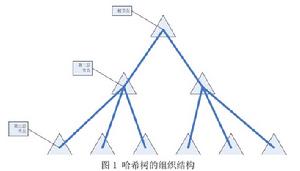散列樹

HashNode();//默認構造函式 HashNode(T1 ~HashNode();
散列樹
我們選擇質數分辨算法來建立一棵散列樹(Hash樹)。
選擇從2開始的連續質數來建立一個十層的哈希樹。第一層結點為根結點,根結點下有2個結點;第二層的每個結點下有3個結點;依此類推,即每層結點的子節點數目為連續的質數。到第十層,每個結點下有29個結點。如下圖所示:
同一結點中的子結點,從左到右代表不同的餘數結果。
例如:第二層結點下有三個子節點。那么從左到右分別代表:除3餘0,除3餘1,除3餘2.
對質數進行取余操作得到的餘數決定了處理的路徑。結點:結點的關鍵字(在整個樹中是唯一的),結點的數據對象,結點是否被占據的標誌位(標誌位為真時,關鍵字才被認為是有效的),和結點的子結點數組。特點
1.哈希樹的結構是動態的,也不像某些哈希算法那樣需要長時間的初始化過程,只需要初始化根結點就可以開始工作。哈希樹也沒 有必要為不存在的關鍵字提前分配空間。2.查找迅速,最多只需要10次取余和比較操作,就可知道這個對象是否存在。哈希樹的查找次數和元素個數沒有關係。3.結構不變,哈希樹在刪除的時候並不做任何結構調整。這也是它的一個非常好的優點。常規樹結構在增加元素和刪除元素的時候都要做一定的結構調整。4.非排序性,哈希樹不支持排序,沒有順序特性。需要注意的是:哈希樹是一個單向增加的結構,即隨著所需要存儲的數據量增加而增大。即使數據量減少到原來的數量,但是哈希樹的總結點樹不會減少。這樣做的目的是為了避免結構的調整帶來的額外消耗。
C代碼
// HashTree.cpp : 定義控制台應用程式的入口點。 //選擇質數分辨算法構造一棵哈希樹 #include "stdafx.h" #include <iostream> using namespace std; const int SIZE = 32;//第10個質數為29,餘數不可能大於32,所以數組的固定長度設定為32 const int Prime[10] = {2,3,5,7,11,13,17,19,23,29}; //哈希結點類型 template<class T1, class T2> class HashNode { public: HashNode();//默認構造函式 HashNode(T1 key, T2 value);//一般構造函式 ~HashNode(); public: T1 m_key; //結點的關鍵字 T2 m_value; //結點的數據對象 bool occupied; //結點是否被占據,如果是表示結點的關鍵字有效 HashNode *child[SIZE]; //結點的子結點數組 }; template<class T1, class T2> HashNode<T1,T2>::HashNode() { occupied=false; memset(child, NULL, SIZE*sizeof(HashNode<T1,T2>*)); } template<class T1, class T2> HashNode<T1,T2>::HashNode(T1 key, T2 value) { this->m_key = key; this->m_value = value; occupied=false; memset(child, NULL, SIZE*sizeof(HashNode<T1,T2>*)); } template<class T1, class T2> HashNode<T1,T2>::~HashNode() { } //哈希樹類型 template<class T1, class T2> class HashTree { public: HashTree(); ~HashTree(); void InsertNode(T1 key, T2 value); bool FindNode(T1 key, T2 &value); void DeleteNode(T1 key); private: HashNode<T1,T2> *root; void Insert(HashNode<T1,T2> *hashNode, int level, T1 key, T2 value);//插入結點 bool Find(HashNode<T1,T2> *hashNode, int level, T1 key, T2 value);//查找 void Delete(HashNode<T1,T2> *hashNode, int level,T1 key);//刪除結點 }; template<class T1, class T2> HashTree<T1,T2>::HashTree() { root = new HashNode<T1,T2>; } template<class T1, class T2> HashTree<T1,T2>::~HashTree() { } template<class T1, class T2> void HashTree<T1,T2>::InsertNode(T1 key, T2 value) { Insert(root,0,key,value); } template<class T1, class T2> void HashTree<T1,T2>::Insert(HashNode<T1, T2> *hashNode, int level, T1 key, T2 value)//插入結點 { if(hashNode->occupied == false) { hashNode->m_key = key; hashNode->m_value = value; hashNode->occupied = true; return; } int index = key%Prime[level]; if (hashNode->child[index] == NULL) { hashNode->child[index] = new HashNode<T1,T2>; } level += 1; Insert(hashNode->child[index], level, key, value); } template<class T1, class T2> bool HashTree<T1,T2>::FindNode(T1 key, T2 &value) { return Find(root, 0, key, value); } template<class T1, class T2> bool HashTree<T1,T2>::Find(HashNode<T1,T2> *hashNode, int level, T1 key, T2 value)//查找 { if (hashNode->occupied == true) { if (hashNode->m_key == key) { value = hashNode->m_value; return true; } } int index = key%Prime[level]; if (hashNode->child[index] == NULL) { return false; } level += 1; return Find(hashNode->child[index], level, key, value); } template<class T1, class T2> void HashTree<T1,T2>::DeleteNode(T1 key) { Delete(root, 0, key); } template<class T1, class T2> void HashTree<T1,T2>::Delete(HashNode<T1,T2> *hashNode, int level, T1 key)//刪除結點 { if (hashNode->occupied == true) { if (hashNode->m_key == key) { hashNode->occupied = false; cout << "關鍵字為" << key << "結點已被刪除!" << endl; return; } } int index = key%Prime[level]; if (hashNode->child[index] == NULL) { cout << "該關鍵字不存在!" << endl; return; } level += 1; Delete(hashNode->child[index], level, key); } int _tmain(int argc, _TCHAR* argv[]) { HashTree<int, int> ht; ht.InsertNode(1, 8); ht.InsertNode(2, 0); ht.InsertNode(3, 4); ht.InsertNode(4, 7); ht.InsertNode(5, 4); ht.InsertNode(6, 3); ht.InsertNode(7, 8); int nvalue = 0; cout << ht.FindNode(5,nvalue) << endl; cout << ht.FindNode(9,nvalue) << endl; ht.DeleteNode(4); ht.DeleteNode(10); cout<<"baasdfas"<<endl; system("pause"); return 0; }

